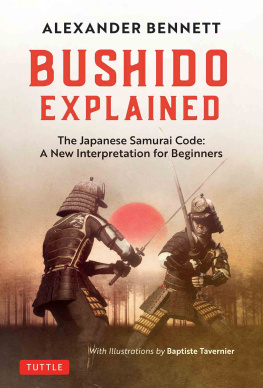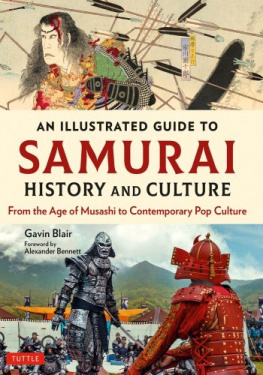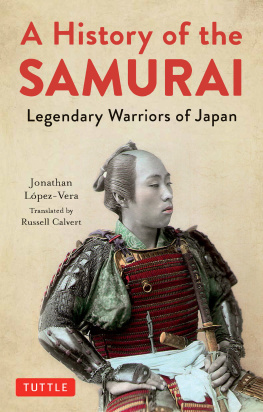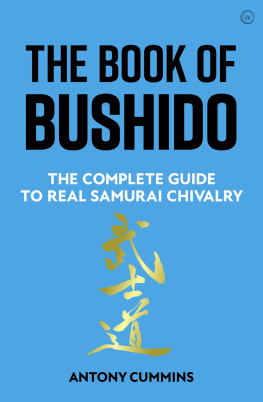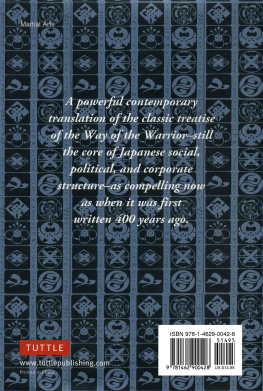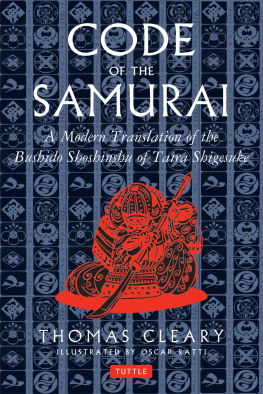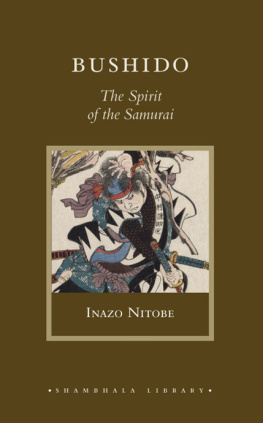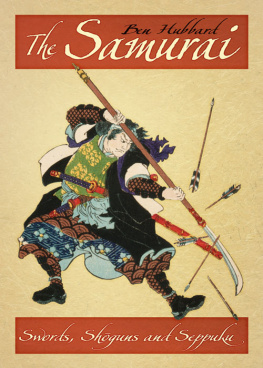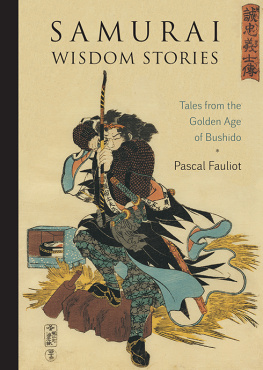Alexander Bennett - Bushido Explained: The Japanese Samurai Code: A New Interpretation for Beginners
Here you can read online Alexander Bennett - Bushido Explained: The Japanese Samurai Code: A New Interpretation for Beginners full text of the book (entire story) in english for free. Download pdf and epub, get meaning, cover and reviews about this ebook. publisher: Tuttle Publishing, genre: Religion. Description of the work, (preface) as well as reviews are available. Best literature library LitArk.com created for fans of good reading and offers a wide selection of genres:
Romance novel
Science fiction
Adventure
Detective
Science
History
Home and family
Prose
Art
Politics
Computer
Non-fiction
Religion
Business
Children
Humor
Choose a favorite category and find really read worthwhile books. Enjoy immersion in the world of imagination, feel the emotions of the characters or learn something new for yourself, make an fascinating discovery.
- Book:Bushido Explained: The Japanese Samurai Code: A New Interpretation for Beginners
- Author:
- Publisher:Tuttle Publishing
- Genre:
- Rating:3 / 5
- Favourites:Add to favourites
- Your mark:
- 60
- 1
- 2
- 3
- 4
- 5
Bushido Explained: The Japanese Samurai Code: A New Interpretation for Beginners: summary, description and annotation
We offer to read an annotation, description, summary or preface (depends on what the author of the book "Bushido Explained: The Japanese Samurai Code: A New Interpretation for Beginners" wrote himself). If you haven't found the necessary information about the book — write in the comments, we will try to find it.
Alexander Bennett: author's other books
Who wrote Bushido Explained: The Japanese Samurai Code: A New Interpretation for Beginners? Find out the surname, the name of the author of the book and a list of all author's works by series.
Bushido Explained: The Japanese Samurai Code: A New Interpretation for Beginners — read online for free the complete book (whole text) full work
Below is the text of the book, divided by pages. System saving the place of the last page read, allows you to conveniently read the book "Bushido Explained: The Japanese Samurai Code: A New Interpretation for Beginners" online for free, without having to search again every time where you left off. Put a bookmark, and you can go to the page where you finished reading at any time.
Font size:
Interval:
Bookmark:
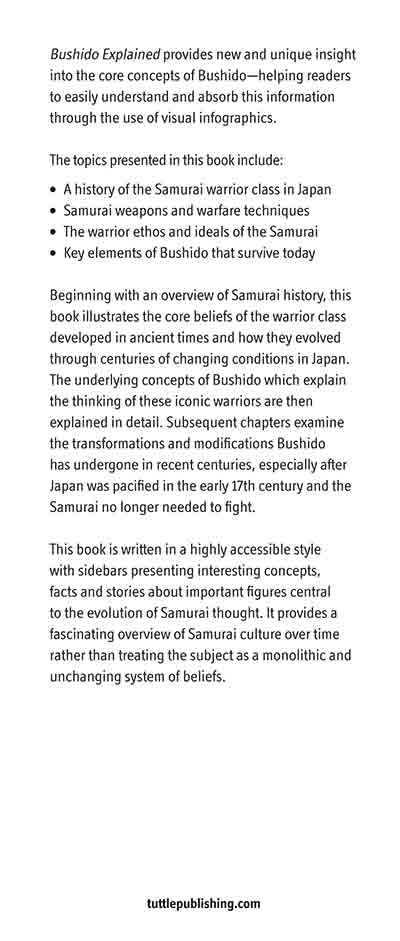
Dedicated to my late teacher,
Takashi Kawakami
BUSHIDO
EXPLAINED
The Japanese Samurai Code:
A New Interpretation for Beginners
ALEXANDER BENNETT
With Illustrations byBaptiste Tavernier

What is Bushido?
P opularly known in Japan and now in the West as the Way of the warrior, Bushido was an ethical code followed by the Samurai heroes of feudal Japan. Many people harbor romantic images of swashbuckling Samurai willingly putting themselves in great danger to fight for a just cause. Living their life on a knife edge, Samurai would ultimately meet their death with a serene smile. Staunchly loyal and honorable men, they embraced physical and mental suffering in their quest to train body and mind.
While this prevailing but somewhat exaggerated image of the indomitable Samurai spirit has enduring appeal, it is too simplistic. All countries have a tendency to glorify their warrior past and proudly embellish its heroic elements as representing the very fiber of their national psyche. Japan is no different. However, much of what has been written about the Samurai, making them out to be superhuman crackerjacks of justice, is pure fiction. This is not to say that the image we have today of fearless Samurai is not entirely without substance. Far from it!
The history of Samurai thought, purportedly built on an apparent contempt for life, provides a genuine doorway into the deepest reaches of the human condition. It is the vestiges of Samurai philosophy and culture that attract millions of people around the world to the Japanese martial arts, not just as competitive sports or for the learning of self-defense, but to access a profound source of timeless wisdom that aspires to self-perfection and peace of mind.
This wisdom is real and is still relevant. To understand its relevance, however, one has to put aside sentimentalized notions of the omnipotent Samurai hero and think of Samurai simply as another group of people struggling to navigate the complexities of the society in which they lived.
Back to the initial question, what is Bushido? There is and can be no single definition. The term itself was one of many for warrior ethics and was, in fact, rarely used until later in the age of the Samurai. Even if Bushido is defined broadly as the Samurai way of life, the huge disparity in warrior ideology and behavior in different eras, regions, political regimes, and even among Samurai of various ranks, cannot be ignored. Nevertheless, for the sake of simplicity, I will use the term Bushido throughout this book.
Generally speaking, warrior ideals in Japan developed in three distinct phases:
The warrior ethos before the Edo period (pre-1600), an ideology forged in an environment of constant warfare. (The reader should note, however, that the term Bushido did not as yet exist!)
The intellectual Bushido developed mainly by Confucian and military scholars during the Edo period (16031868), an extended time of relative peace when the warrior spirit was refocused on self-cultivation to maintain social order.
The modern repackaging of Bushido in the Meiji period (18681912) and beyond. This phase represents a dramatic reinterpretation of Samurai culture in the formulation of a new Japanese national identity. To this day, many Japanese people associate Bushido with Japanese-ness and as the source of their most noble national traits.
An examination of the most emblematic texts from each period shows how the Way of the warrior was constantly evolving. For example, war histories from around the early medieval Kamakura (11851333) and Muromachi (13361573) periods, such as The Tale of the Heike and the Taiheiki, portray an ideal centered on faithfulness to ones lord and reckless abandon in battle. This was indeed the ideal, which means that the reality was a very different story. In real terms, early medieval allegiance was honed by economic considerations. Samurai actively and selfishly pursued their own interests in a you scratch my back and Ill scratch yours type of contractual fealty, a relationship of mutual benefit referred to as goon tohoko (reward for service).
On the other hand, later medieval texts such as the Koyo-gunkan, written around the end of the 16th century when Japan was emerging from a century and a half of constant civil war, provide a window into the Samurai psyche at a time when treachery and disloyalty were an ever-present reality.
Typically glorifying the history of the clan they were written about, these commentaries offer practical advice to ensure survival in times of pandemonium. Compared to the earlier literature, the demands on Samurai of the 16th century meant that the content was more pragmatic and often scornful of enemies and irresponsible clansmen. Part propaganda and part reproach, the chronicles are fine examples of historical revisionism. As such, the reliability of the content is questionable. Reading between the lines, however, the true value of the texts is found in realistic insights into the anxieties faced by these professional men-at-arms and their struggle to prevail.
Once peace and stability enveloped Japan during the Edo period, warrior thought matured into sophisticated articles of faith incorporating Confucian and Taoist ideals of social order and governance as well as Buddhist appreciation of the ephemeral world championing the aesthetic of death.
Representative works from this period include Miyamoto Musashis Gorinno-sho (Book of Five Rings) and Yagyu Munenoris Heiho Kadensho. Both were written by master swordsmen in the early Edo period and both testify to how the art of war could be applied to all aspects of life in addition to fighting.
The orderly climate of the mid to later Edo period (18th and early 19th centuries) nurtured clearly defined ethical codes for a tamed Samurai class. This was a golden age for Samurai ideology, which drew on shared experiences of the past mixed with new age considerations to help redefine the warrior raison dtre in a time of peace.
Loyalty to the point of death and other idioms of Samurai honor endured but were demonstrated through impeccable behavior in daily life rather than in the thick of battle. After all, there were no more battles to be involved in. The prominent scholar and strategist Yamaga Soko, for example, lectured that to justify the privileged existence of the Samurai in an era when he no longer needed to fight, their duty was to provide moral leadership. In fact, as recipients of stipends, Samurai lived off the backs of those who toiled in the fields. The function of a warrior in a peaceful society, Soko argued, was to be a role model for the common people by fulfilling their duty and willingness to protect those who grew the food they ate.
Selfless dedication to service was also the main message in Yamamoto Jochos classic book, Hagakure (1716). Jocho (aka Tsunetomo) declared that the role of Samurai of the Nabeshima clan was to fortify resolve to sacrifice their lives for the greater good of the domain and for the lord. One achieved this, according to Jocho, by living as if already dead.
One of Jochos contemporaries, Daidoji Yuzan, wrote another Bushido classic, Budo Shoshinshu (ca. 1725). His work weaves indigenous Shinto and Confucian ideals into a how to be a Samurai compendium outlining appropriate behavior for all warriors irrespective of clan affiliation. He underscored strict adherence to protocol as an indicator of honor and mindfulness of death to avoid conflict altogether.
Next pageFont size:
Interval:
Bookmark:
Similar books «Bushido Explained: The Japanese Samurai Code: A New Interpretation for Beginners»
Look at similar books to Bushido Explained: The Japanese Samurai Code: A New Interpretation for Beginners. We have selected literature similar in name and meaning in the hope of providing readers with more options to find new, interesting, not yet read works.
Discussion, reviews of the book Bushido Explained: The Japanese Samurai Code: A New Interpretation for Beginners and just readers' own opinions. Leave your comments, write what you think about the work, its meaning or the main characters. Specify what exactly you liked and what you didn't like, and why you think so.

